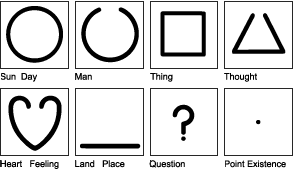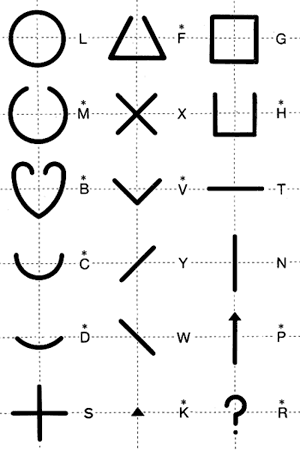
|

Do you want to learn how to read and write LoCoS? Follow our simple guide and you'll be using LoCoS in no time.
What is LoCoS?
LoCoS is a set of pictograms and ideograms, or "pictures" and "idea-symbols".
Its name comes from the phrase "Lover's Communication System", a title inspired
by the hope that people from around the world could use LoCoS to communicate in
the effortless manner of lovers.
LoCoS is extremely easy to learn, and it is an ideal way to communicate with
people who speak a different language. In the future it may even allow human beings
and computers to interact more easily!
How do I write words in LoCoS?
Each word in LoCoS is represented by a symbol formed from simple shapes.
LoCoS has several fundamental symbols. For example, "Sun" or "day" is represented
by the outline of a circle, and the concept of "feeling" is shown by aheart
shape. The idea of existence at a particular point in time or space
(the "point existence") is shown by a single dot. It was inspired by
the use of dots to indicate locations on a map.
 Simple nouns, such as "eye" or "fish" also have self explanatory symbols.
Simple nouns, such as "eye" or "fish" also have self explanatory symbols.

All other concepts and nouns can be created by combining basic symbols.
For example, a circle ("day") with a dot inside it ("point existence") means
"today", and the symbol for "man" containing the symbol for "fish" means
"fisherman". It's as easy as that!

How do I write an expression in LoCoS?
To write a useful expression, we need to use verbs. A horizontal bar has the
verb form of "do". All nouns become verbs when they are placed to the right
of the bar. Past and future tenses of the verb are indicated by using a dot
("point existence") with the bar -- a dot on the left end means past, a dot
on the right end means future. For example, different combinations of a bar
and a dot to the left of the symbol for "eye" creates the various tenses of
the verb "to see".

Complete LoCoS expressions, which are equivalent to sentences, are formed
by three rows of symbols. They are always read from left to right. The main
contents are placed in the center row. Symbols in the top and bottom rows act
as adverbs and adjectives respectively.

Can I speak LoCoS? How do I write my name in LoCoS?
To speak LoCoS, or to write the names of
people and places, we must learn the simple rules for the pronunciation of LoCoS
symbols. These rules can be used to identify a unique sound for each LoCoS symbol.
They can also be used to compose LoCoS versions of proper nouns – we simply create
a set of symbols that reproduce the correct sequence of sounds.
The rules are quite simple. 18 of the basic shapes that form all LoCoS symbols are
assigned a consonant. In addition, the square space containing each symbol is
divided into a 3 by 3 grid. Each of the nine positions in this grid correspond
to a vowel sound.


The sound for each visual element is a combination of its consonant sound and the
vowel associated with its position within the square. Some visual elements (those
marked by an *) can have different orientations at each position. In those cases
we also add the vowel sound towards which the element is pointed. The sound for
the complete symbol is simply a combination of the sounds for the separate visual
elements. For example, the LoCoS pronunciation of the symbols for "entrance" and
"house" are "hoipo" and "vaiho" respectively. Similarly, we can construct the
name Ota (the surname of the inventor of LoCoS) using just two symbols!

Where can I see more LoCoS?
There are many more examples of LoCoS symbols and expressions in our gallery page.
|